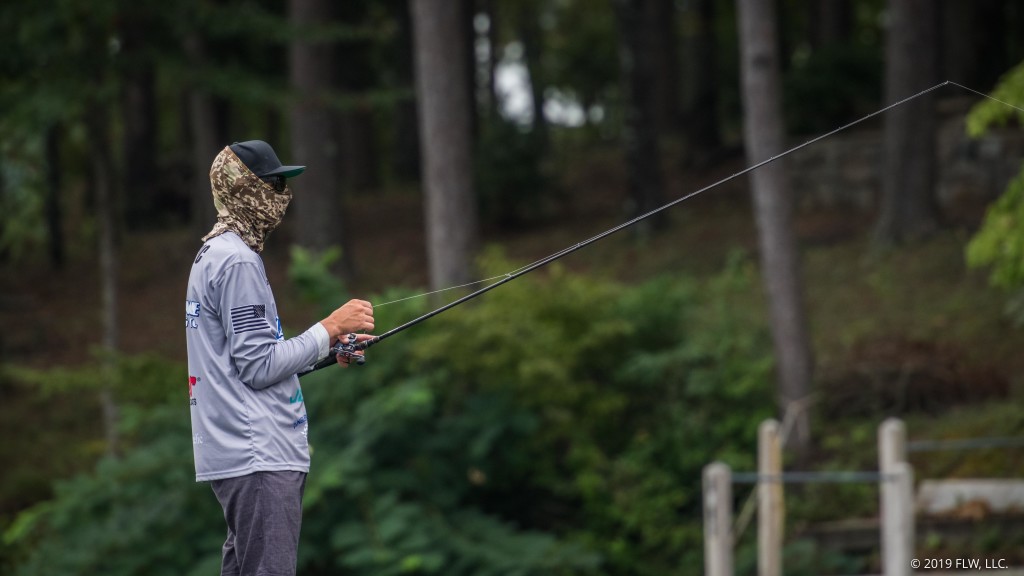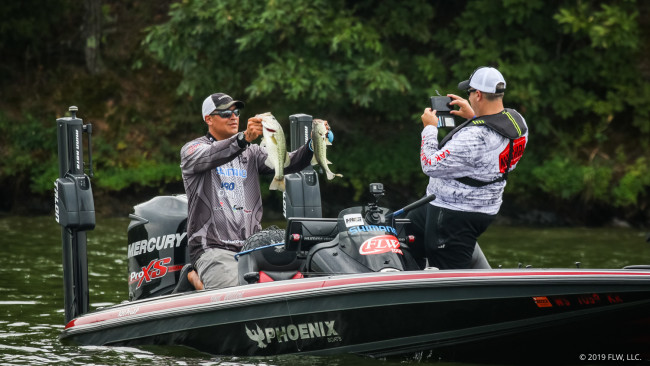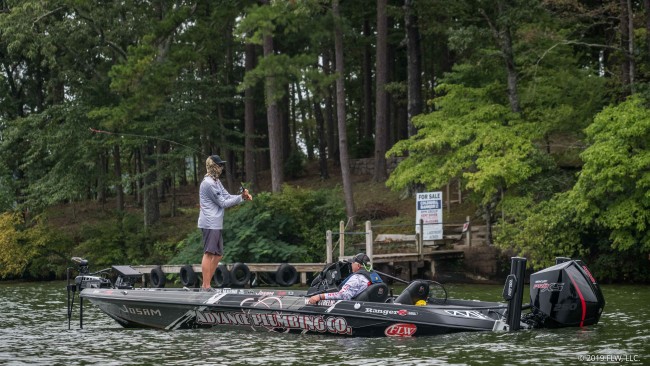Slow Down in Brush for More Success
How Strelic and Willert added bites on Hamilton

The FLW Cup featured a lot of brush pile fishing, which isn’t unusual for the South in the summertime. Being able to find and fish brush piles is important on basically any lake that has them, and it’s often especially key in the warmer months when bass aren’t concerned about moving to or from spawning areas and the water is hot.
Many times, hitting as many brush piles as possible is the key to success, with Bryan Thrift’s 2015 FLW Tour win on Lake Eufaula serving as a prime example of that strategy. However, with the fishing pretty tough on Lake Hamilton, both Wade Strelic and Joel Willert turned to more methodical approaches to generate bites.
Fishing 11th and 12th in the Cup, respectively, Strelic and Willert both caught some key fish from brush piles, and they discovered that the best way to catch them was by fishing worms strikingly slowly, sometimes taking two minutes or more at a time to complete a cast.

Figuring it out
Both pros ended up fishing super slow in brush quite a bit, and they did so for essentially the same reason: They knew there were fish there, and they were determined to catch them.
“I figured it out in practice, where I would idle over the brush piles and I could see the fish down there on my 2D or my Down Imaging,” says Willert. “I couldn’t get those dang things to bite, and I would sit on a brush pile for 15 or 20 minutes sometimes and keep throwing in there and not get bit. And then all of a sudden 20 minutes later you’d get bit and it’d be a good one.
“My thought behind it was that those fish were sitting there, they’re pressured, and basically you have to make them eat. You dangle that worm in front of them long enough, and they’re going to get sick of it and have to eat it. I compared notes, and Josh Douglas and I were basically running the same pattern in the brush, and we both came up with the same thing.”
Willert says that he didn’t plan on fishing the brush as slowly as he did, but once it became apparent that was key to getting bit he dove right in. For Strelic, a native of southern California, really milking the brush came more naturally.
“Every single brush pile held bass,” says Strelic. “It wasn’t like some lakes we go to where you have to cover miles of water. You could spend all day graphing brush piles, and there’d be fish in all of them. That’s like back home. There’s winning bass in almost every spot you fish back home. It’s just a matter of getting them to bite. That’s why you have to fish so slow and so thorough to try to trick them.”
By slowing down, Strelic saw an opportunity to further differentiate himself from the pack.
“I tried to slow down in the tournament,” relays Strelic. “You’d see a lot of the guys throw that big worm out and sweep their rod 4 or 5 feet at a time. A lot of the brush piles I was getting bit out of were small brush piles. They’d take three or four casts just to find, so when I did find it I didn’t want to move it much. I had a lot of confidence that there were good fish in there, but if you pulled it a foot you’d be out of it. So, you might as well keep it in there once you got it there.”

Different strategies produced
While both anglers fished worms super slow in brush, they had a few key differences in their presentations.
Willert used either a 1/4-ounce drop-shot with a 6-inch Roboworm Straight Tail Worm or a Texas rig with a 1/2-ounce Swagger Tackle Tungsten Worm Weight and a 10-inch worm.
“I didn’t fish that many brush piles in the tournament. I kind of boiled it down to four or five brush piles even though I had 60 or 80 marked,” explains Willert. “I started to figure out toward the end of practice which ones I could get bit on. You could tell which ones were fresh, and which ones were more broken down. I started to put it together that the ones that were taller and cleaner were the best ones, and with how slowly I was fishing I couldn’t run them all.
“I’d feel every single piece of brush down there, and keep shaking my worm and bringing it up and over every limb. I just kept envisioning a fish sitting there staring at it not wanting to eat it. I just figured if I kept holding it there eventually it would come up and grab it. Each cast would take me five minutes or longer. I spent more time with my bait in the strike zone versus making more casts.”
Strelic took an approach he’s dialed in over the years fishing in California. He Texas-rigged two worms to get the job done. The first was a red bug-colored Zoom Ol’ Monster with a 1/4-ounce weight. The second was a Roboworm Fat Straight Tail Worm with a 3/16-ounce weight in Martens madness, margarita mutilator and red crawler.
“I was fishing a lot of the bigger brush piles, but then I noticed everyone was starting to fish them,” says Strelic. “So, I started looking for the smaller brush piles. They were on the main river channel; anything steep and vertical that had hard rock on it in 12 to 15 feet, right on the break. They were hard to find. You had to graph over them four or five times sometimes, and it would only pick up on your Down Imaging. You couldn’t even see it on Side Imaging.”
Because the piles he was fishing were smaller, it often took Strelic a few casts to hit them. So, he wanted to make the most of it when he did.
“I would let it sit, and if I was over a limb I would pick it up, get to the top of a branch, and instead of pulling it over I’d let it fall back down,” he says.
Though he fished both worms on a baitcaster, Strelic opted for lighter weights than usual for a more snagless presentation.
“I fish a lot of brush back home, and there I throw a 1/8-ounce weight,” says the Californian. “I feel like if you get hung up you ruin the brush, so instead of just dredging through with a 1/2-ouncer, the 3/16-ounce was the perfect combo. It casts well, and once it gets down there it won’t hang up. I hate when you finally find that good pile and you break off in it and the pile is ruined.”
Unlike Willert, who often spent 30 minutes or more on a brush pile, Strelic kept moving. He’d make a handful of super-slow casts in each pile he fished, but he’d move on after that.

Making things work
The stress of tournament fishing is one of the best ways to prove a tactic, and that stress is doubled in the FLW Cup, which features top-notch competition on top of typically tough fishing. Soaking worms in brush isn’t likely to be productive in every lake, or at least not very efficient, but it certainly had a place at Hamilton. If you’re struggling around home in the summer, or you need to generate a kicker or two, it might make sense to try slowing down.